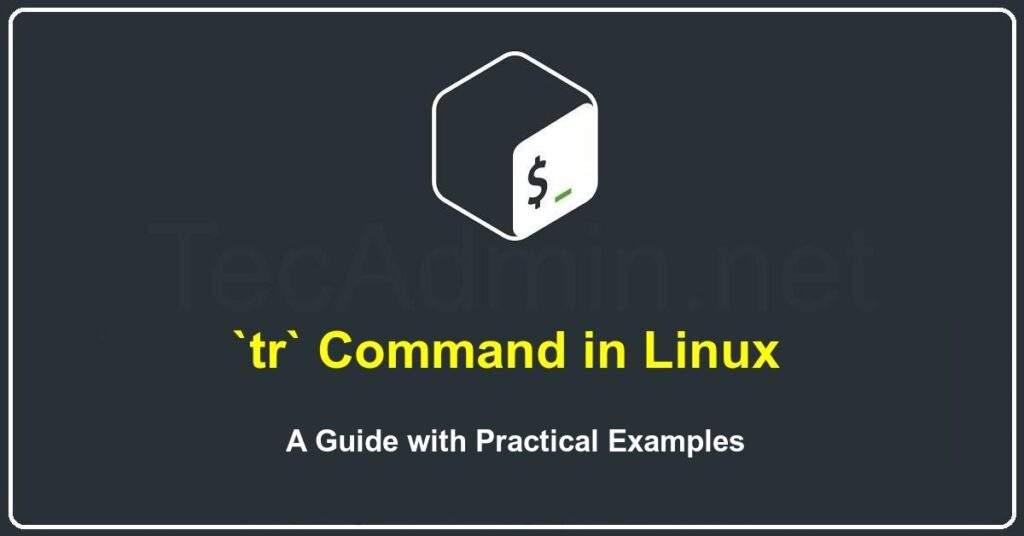Linux, like any robust operating system, is built to handle various types of errors. One such error that often perplexes beginners and even intermediate users is a Segmentation Fault, colloquially referred to as ‘segfault.’ This article aims to provide a comprehensive understanding of segmentation faults and offer pragmatic troubleshooting measures to handle them effectively in a Linux environment. What Is a Segmentation Fault? A Segmentation Fault is an error that occurs when a running program attempts to access a memory location not allocated to it or tries to perform an operation not permitted in that particular memory segment. This illicit…
Author: Rahul
In the realm of Linux, the `tr` command is a vital tool that users can employ for text processing. TR, short for translate, is utilized to translate or delete characters from standard input, writing to standard output. It may seem simple on the surface, but the `tr` command offers a great depth of functionality. This article aims to guide you through the nuances of the `tr` command, providing practical examples along the way. Basics of TR Command The `tr` command is generally used in the following structure:
1 | tr [options] "set1" "set2" |
Here, set1 and set2 are character sets. The `tr` command replaces the…
Linux, the powerful open-source operating system, offers flexibility and customization opportunities that are often unattainable with other platforms. One area where this flexibility becomes particularly apparent is in managing environment variables. The `/etc/environment` file in Linux plays a pivotal role in this aspect. But what exactly is it, and how can it be used effectively? Let’s dive in. What is the /etc/environment file? Before we delve into the how, it’s crucial to understand what the `/etc/environment` file is. It is a system-wide configuration file in Linux that is read upon system boot. This file is utilized to set up environment…
Bash, the Bourne Again SHell, is an incredibly powerful tool for managing and manipulating data. It offers a rich array of features, one of which is the ‘Here String’ (
The Linux environment is known for its strong structure, detailed control, and many useful tools. One interesting part is the /dev/null file. It may seem confusing, but it is important in Linux for managing processes. This article will explain what /dev/null is, its purpose, and how it is used in Linux. Understanding the Linux File System Before talking about /dev/null, it’s important to understand the Linux file system. In Linux, everything is treated as a file—hardware, directories, and even processes. This way, users and programs can interact with everything using simple commands like read, write, or delete. The /dev directory…
Bash, the Bourne-Again Shell, is a very flexible and powerful command language interpreter used in Unix and Unix-like operating systems. It can do many things, including handling date and time information. One useful task is getting yesterday’s date. This may seem simple, but it is very helpful in script writing and automation tasks. In this article, we’ll learn how to get yesterday’s date in Bash. We’ll start with basic Bash commands, learn about the date command, and finally, get yesterday’s date using Bash scripting. The date Command Before we get yesterday’s date, we need to understand the date command in…
In the world of system administration and shell scripting, handling dates and times is very important. Whether you’re scheduling tasks, rotating logs, or simply adding timestamps to files, knowing how to work with dates in your scripts can save you a lot of time and effort. Bash, the Bourne Again Shell, has powerful tools for this purpose. In this article, we’ll show you a simple example: how to get tomorrow’s date using Bash. There are several ways to do this, and we’ll go through a few examples using basic tools like date and GNU date. The Date Command in Bash…
Secure File Transfer Protocol (SFTP) is a secure protocol for transferring files between local and remote servers. Unlike standard FTP, it uses SSH (Secure Shell) to encrypt all data transfers, protecting against common threats like data interception and packet sniffing. In this guide, we will detail the steps to set up an SFTP server on an Ubuntu machine. Prerequisites Before starting, ensure you have: A machine running Ubuntu (version 18.04 or later is recommended for the best compatibility) SSH installed on your Ubuntu machine. This is usually pre-installed on most Ubuntu distributions. Sudo privileges or root access to the Ubuntu…
Cron is a task scheduler in Unix-based operating systems. It is used to schedule commands or scripts to run periodically at fixed times, dates, or intervals. This feature can be particularly useful for automating system maintenance or administration tasks. One common use case for Cron is to automate scripts written in PHP, a popular server-side scripting language. This article will walk you through how to schedule a Cron job for a PHP script, providing practical examples for better understanding. Step 1: Understand the Basics of Cron Syntax Before setting up a Cron job, it is important to understand the basic…
In computing, especially on Unix and Unix-like operating systems such as Linux and macOS, there exists a concept of hidden files and directories. These are special types of files and directories that are not typically visible when listing contents in a file manager or a command-line interface. This article aims to provide an in-depth understanding of hidden files and folders in your home directory. The Concept of Hidden Files and Folders The central idea behind hidden files and directories is to prevent clutter while protecting important files from accidental modification or deletion. This is especially significant for configuration files, which…




